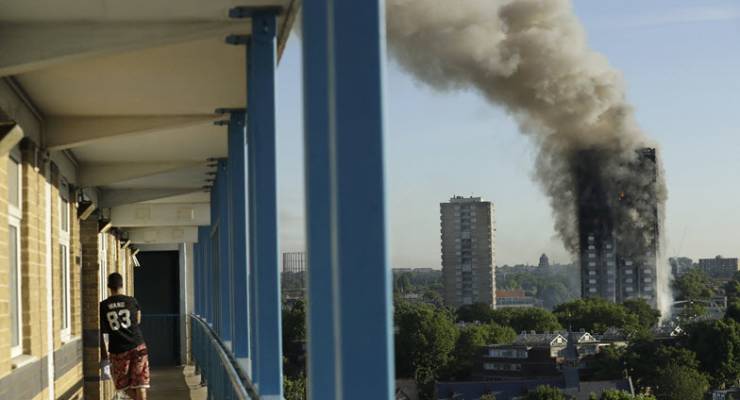
Yesterday, news.com.au repurposed a moral outrage for its local audience that international News Corp properties were done with a month ago. It was reported by The Sun in the days following London’s Grenfell Tower fire that so-called “dark tourists” were snapping self-portraits at the disaster site.
It’s awful news, of course, and the pain felt by survivors of the horror, expressed in signs like “It’s a tragedy, not a tourist attraction”, is immediately fathomable to any breathing human. The fact of rubberneckers was also entirely predictable. News.com.au may have placed the story in its “gadgets” section, as though the practice of visiting sites of recent horror was somehow made new by the introduction of digital technology. But dark tourism — or “thanatourism” if you prefer the posh word for what has become in the past twenty years a subsection of academic inquiry — has been a peculiar, and cross-cultural, pastime for an awfully long time.
Pilgrimages by Christians to the site of a martyr’s death were monetised centuries ago. Public executions were once considered suitable entertainment — even for 18th-century French women, who sat by the guillotine with their knitting, never dropping a stitch as elite heads rolled. Per the US historian Daniel Boorstin, England’s very first professionally guided tour was an 1838 train excursion to Cornwall to witness the hanging of two murderers.
We are now largely done with our illiberal bloodlust and now prefer to reflect on death rather than to revel in it. Dark tourism, a pastime some scholars reasonably propose is something to which a death-obsessed species is inevitably drawn, tends to be more organised. Certainly, the line between commemoration and schoolies week is blurred in the partying by Australians at Gallipoli, but other significant sites of common memory tend to be respected.
A few years back, much was made of the decision by a US teenager to take a smiling selfie at Auschwitz. The image that the young woman posted was replicated by thousands of angry internet users and gave rise to hundreds of moralising “what has our modern world come to?” pieces of the News Corp sort. One commentator expressed surprise that a 14-year-old product of the wretched Alabama public school system could have any interest, however inappropriate, in history at all, and a few softer thinkpieces followed, several of them citing the study of dark tourism and making the case that the teen, herself grieving for a father who had ignited her interest in world events, was enjoying a teachable moment.
I remember, as a teen myself, travelling to the Dachau memorial and, being me, scolding a happy American couple as they prepared to take photographs of each other under the sign for “badezimmer”, or bathroom, that signified an infamous Nazi deception. “How could you be so disrespectful?!” I cried to the pair, one of whom, as it turned out, was a Holocaust survivor. I have since learned to not to be such a pompous goy.
People will do what they do at sites of horror, and even when their motivations appear improper, they may have true grief at their core. Or, at the very least, a desire to make the history history, as I am certain was the case with a Jewish husband and wife who were not, as I had presumed, laughing at loss, but celebrating their survival.
There’s a nice quote from Marina Novelli, a UK professor of tourism. She says that dark tourism, whether spontaneous as in the case of “rubbernecking” or organised such as that at Port Arthur, is an effort to differentiate the present from the past, to declare that this awful thing is over. “This does not mean,” she writes, “that all history is dark tourism. But all dark tourism is history.”
The urge to make sense of the past is a preoccupation for nearly everyone, save, perhaps, for especially proficient Buddhists. From Hegel to an Alabama teen, the urge to understand the individual’s place in history is ongoing. None of which is to church up the actions of people who stare at car collisions, or many of those who smile beside the charred remains of a life in the most miserable part of London’s richest borough. But it is to say, as dark tourism scholars assert, that folk can do odd stuff for common reasons.
Nearly 30 years after adolescent me had scolded Holocaust survivors for daring to smile, Holocaust survivors were scolding adolescents for doing the same. A Facebook page called With My Besties in Auschwitz was reportedly created by an Israeli woman who had visited the death camp sites and was struck by the way her countrymen and women took selfies. “I just thought there was something grotesque in tagging #mountofash next to a mount of ash in Majdanek, or in making a ‘sexy’ or ‘seductive’ face next to a crematorium. What is this supposed to mean exactly — I look hot in Auschwitz?! Turns out many people agreed with me,” she told The New Yorker.
The creator, who received as much critique as the posing teens did, explained that she was documenting these social media moments to rescue the act of commemoration which, in her view, had been whittled down to almost nothing by Israeli nationalist politicians. Looking hot in Auschwitz, in her view, was every bit as inappropriate as looking to Auschwitz not as a legitimate memory, but as a pretext for policy. Her virtual dark tourism was, in one reading, an effort for history.
As much as media, most especially conservative outlets, might critique the selfie-takers at Grenfell, dark tourism is a very old practice, and hardly a disorder of the present. Grenfell itself, of course, is a disorder of the neoliberal present, which may help explain News Corp’s eagerness to invent another one. I am certain, of course, that former residents were hurt and appalled by the intrusion. But, perhaps not as appalled as they were about their lack of secure housing, the refusal of Theresa May to consider Jeremy Corbyn’s popular proposal to requisition vacant investment properties in the postcode or the fact that many of them remain in budget hotels far from home.
To say that the UK Prime Minister has recently had ears of tin is to do a disservice to the periodic table. May has not responded, either practically or symbolically, to the loss of life and faith felt by the British people. There has been no housing solution yet proposed and no adequate form of public commemoration. If public leaders fail to make sense of a horror in which they, and previous leaders, have been complicit, other will make sense of it for themselves. Even if with a smiling selfie.








Jack the Ripper yours seem to still be quite popular in the East End of London. No one seems to be too upset by them? I guess the issue is how long does it take for an event to be seen as history versus a current event. Not withstanding the investigation of the brutal murders of London sex workers as a form of entertainment might in itself still be seen as a bit not quite right perhaps?
Some people aren’t too thrilled by Jack the Ripper tourism:
http://www.independent.co.uk/news/uk/home-news/jack-the-ripper-museum-sparks-protest-with-offensive-halloween-event-offering-selfies-serial-killer-a6715386.html
Hmmm good link. I had not seen that. Thanks.
I was going to comment that I’ve been to Dachau and was appalled to see a Japanese tourist taking numerous photographs of the exhibits there.
I should note that Dachau was never a death camp in the way that Treblinka and part of Auschwitz were. If you were incarcerated in Dachau, you had a chance of surviving the night, which didn’t apply to Treblinka (it was a death facility not a death camp). The bathhouse deception was not part of Dachau’s history, dreadful though it was.
In another life I worked in the business media and one night I went to a corporate function/product launch type thing at the Old Melbourne Gaol. It was something to do with the internet and legal information, so it made sense (law + hip & edgy), but it was still kind of creepy.
Thanatourism is offensive when it is a subset of egotourism – and it is true that both have been about for a long while. You can find Lord Byron’s name carved into the marble at Sounion and probably in some dank cell under the Colosseum etc etc ad nauseam. But I still think the millennials can stand a lecture or two. It’s the selfies now that have ratcheted things up to a new height. “Here I am looking huuuuge in front of … David, Dachau… whatever…” At least Byron had to remember to bring along a chisel and then work at it a bit. In his day, egotourist narcissism wasn’t just casual, reflexive, meaningless, deluded love of self. It was the real thing.
Excellent article Helen. May is doing her best to make sure the Tories lose even more badly at the next elections. As for the Fake News perpetrators, they’re always up for whipping up moral outrage. It sells newspapers for them whether justified or not: mostly not.